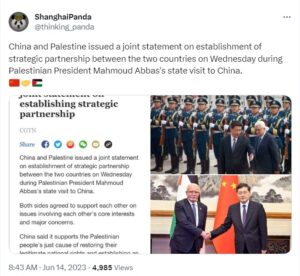The half-journalism that has become a predictable part of New York Times Mideast coverage looks, in one recent example, like this:
After peace negotiations collapsed in 2014, there appears to be little chance of their near-future resumption, with or without Chinese involvement: Both Israelis and Palestinians are deeply divided and cannot agree among themselves about how to approach the conflict, let alone find common ground with the other side. Israel’s current government is its most right-wing ever, few of its members support the concept of Palestinian sovereignty, and Chinese intervention is unlikely to change that.
If whole-reporting seeks to fully and fairly cover the world, half-reporting covers — and covers-up. In the above case, the reporters* acknowledge, in a general way, that divisions on both sides of the conflict complicate peacemaking. And then they elaborate — on half the story. Israelis and Palestinians are divided. Here’s the problem with Israel. It’s a particularly odd equation, since the news story is about a Palestinian visit to China, without an Israeli in sight.
* The piece is written by China correspondent Vivian Wang, but Jerusalem-based Patrick Kingsley and Hiba Yazbek contributed reporting and are likely responsible for the quoted passage.
Here is what whole-reporting might look like, were the Times more interested in exposing readers to the Palestinian role in the conflict:
After peace negotiations collapsed in 2014, there appears to be little chance of their near-future resumption, with or without Chinese involvement: Both Israelis and Palestinians are deeply divided and cannot agree among themselves about how to approach the conflict, let alone find common ground with the other side. Israel’s current government is its most right-wing ever, few of its members support the concept of Palestinian sovereignty, and Chinese intervention is unlikely to change that.
Palestinians, meanwhile, are governed in the Gaza Strip by Hamas, an antisemitic fundamentalist group sworn to Israel’s destruction. Much of the world considers Hamas a terrorist organization. The Palestinian leadership in the West Bank, while more moderate than Hamas, still rejects the existence of a Jewish state, and has rejected peace plans that would have created a Palestinian state and ended the conflict.
But as the newspaper has shown us again and again, it is not particularly interested in shining a spotlight on Palestinian comportment. “For the international press, the uglier characteristics of Palestinian politics and society are mostly untouchable,” explained former AP journalist Matti Friedman in his indispensable 2014 essay, “because they would disrupt the Israel story, which is a story of Jewish moral failure,”
In this case, Uyghurs, too, might be frustrated by the newspaper’s half-reporting — its reluctance to hold Palestinian leaders accountable for their extreme positions. On June 14, the Palestinian Authority expressed support for China’s repressive policies targeting Uyghurs and other Muslim minority groups in China’s Xinjiang province. After a meeting between Chinese president Xi Jinping and Mahmoud Abbas, the Palestinian leader in the West Bank, the sides released a joint statement “endorsing Beijing’s domestic and foreign policies and repudiating Western concepts of human rights,” the Associated Press reported.
In the statement, the Palestinian Authority said issues regarding China’s policy toward Muslims in Xinjiang have “nothing to do with human rights and are aimed at excising extremism and opposing terrorism and separatism.”
“Palestine resolutely opposes using the Xinjiang problem as a way of interfering in China’s internal affairs,” the joint statement said.
That echoes Chinese propaganda surrounding the detention of more than 1 million Uyghurs, Kazakhs and other Muslim minorities in prison-like detention centers on little or no legal grounds — often merely for having a relative studying abroad or downloading the Koran onto their phones.
The joint statement had already been publicized early in the morning of June 14 (Eastern Time). And the New York Times story, published online that day, was updated later that morning and again that evening. But the piece said nothing about Palestinian backing for a Chinese crackdown that, as the paper had previously reported, is believed by some observers to amount to crimes against humanity or even genocide.

Details of the China-Palestinian Authority joint statement were available Wednesday morning, long before the Times story on the visit was last updated.
Why? It’s not that the paper is generally disinterested in the uncomfortable facets of international relationships. About Hungarian-Israeli relations, for example, the Times made a point of telling readers that Israeli prime minister Benjamin Netanyahu “has increasingly embraced illiberal democracies like that of Hungary — whose far-right prime minister, Viktor Orban, arrived in Jerusalem for a friendly visit only hours before the vote.”
In this story, though, there is nothing illiberal about Abbas’s Chinese partners. Nothing authoritarian. Nothing repressive. Instead, readers are told, in what might be the story’s harshest language, that “Mr. Xi has been working to burnish his image as a force for global peace in recent months.”
But the reason for these omissions has less to do with China than with their Palestinian co-signers, whose extremism vis-a-vis Israel the New York Times too frequently whitewashes.
The whitewashes certainly extend to world of international diplomacy, too. In early 2016, for example, Benjamin Netanyahu critiqued a statement by the US ambassador to Israel, saying that statement was “unacceptable and incorrect.” Just fourteen months later, Mahmoud Abbas called the subsequent ambassador an overall “son of a dog.” The Times quickly reported on the former. It ignored the latter news.
But that, after all, is how the paper’s half-reporting tends to cover — and cover-up.
